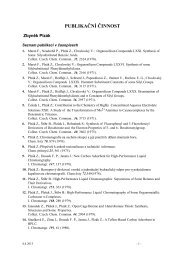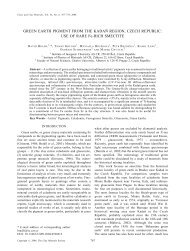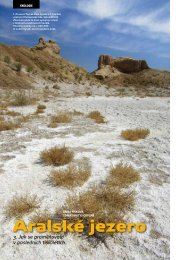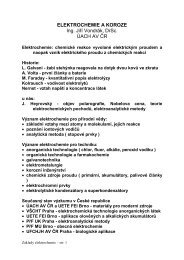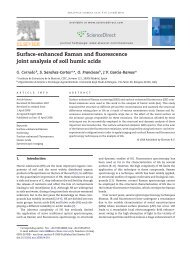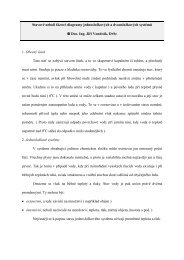Microanalytical identification of Pb-Sb-Sn yellow pigment in ...
Microanalytical identification of Pb-Sb-Sn yellow pigment in ...
Microanalytical identification of Pb-Sb-Sn yellow pigment in ...
Create successful ePaper yourself
Turn your PDF publications into a flip-book with our unique Google optimized e-Paper software.
D. Hradil et al. / Journal <strong>of</strong> Cultural Heritage 8 (2007) 377e386<br />
381<br />
lattice. When 5 or 10% <strong>of</strong> f<strong>in</strong>e SiO 2 (silica gel) was used, the<br />
product had a p<strong>in</strong>kish orange, salmon hue. The pure, s<strong>in</strong>gle<br />
phase Naples <strong>yellow</strong> had a warm <strong>yellow</strong> hue, with a significant<br />
red coord<strong>in</strong>ate <strong>in</strong> CIE-L*a*b colour space (Table 2).<br />
Pure <strong>yellow</strong> without or almost without reddish or ochreous<br />
hue was obta<strong>in</strong>ed much easier than Naples <strong>yellow</strong> <strong>in</strong> the<br />
presence <strong>of</strong> <strong>Sn</strong>O 2 (Table 2). Calc<strong>in</strong>ation <strong>of</strong> <strong>Pb</strong> 3 O 4 , <strong>Sb</strong> 2 O 3<br />
and <strong>Sn</strong>O 2 with 10% NaCl at 700, 800, or 900 C produced<br />
<strong>Pb</strong> 2 <strong>Sb</strong> 2 x <strong>Sn</strong> x O 7 x/2 with the pyrochlore structure, usually as<br />
a mixture <strong>of</strong> two pyrochlore structures with different cell sizes<br />
and commonly with a trace <strong>of</strong> non-consumed <strong>Sn</strong>O 2 (Table 3).<br />
Both pyrochlores have always the lattice size larger than Naples<br />
<strong>yellow</strong> (Tables 1 and 3) hence it can be used for <strong>identification</strong><br />
<strong>of</strong> the lattice substitution, i.e. the presence <strong>of</strong> <strong>Pb</strong>-<strong>Sb</strong>-<strong>Sn</strong><br />
<strong>yellow</strong>. The bimodality <strong>of</strong> the lattice size was observed <strong>in</strong> both<br />
<strong>Pb</strong>:<strong>Sb</strong>:<strong>Sn</strong> compositions tested (2:1:1 and 2:1.5:0.5). It is not<br />
clear whether this phenomenon has a k<strong>in</strong>etic or a thermodynamic<br />
nature. Surpris<strong>in</strong>gly, the same bimodality <strong>in</strong> the cell<br />
size <strong>of</strong> <strong>Pb</strong>-<strong>Sb</strong>-<strong>Sn</strong> <strong>yellow</strong>s was also found <strong>in</strong> real artworks<br />
(Table 3, Fig. 1), prov<strong>in</strong>g that it was not a specific drawback<br />
<strong>of</strong> our synthesis route.<br />
As it was found <strong>in</strong> Naples <strong>yellow</strong> specimen prepared <strong>in</strong><br />
K 2 CO 3 flux, also this element can <strong>in</strong>crease the cell size <strong>of</strong><br />
the pyrochlore almost to value typical for <strong>Pb</strong>-<strong>Sb</strong>-<strong>Sn</strong> <strong>yellow</strong>.<br />
The <strong>identification</strong> <strong>of</strong> the lattice size <strong>of</strong> the pyrochlore <strong>pigment</strong>s<br />
should hence also <strong>in</strong>clude <strong>identification</strong> <strong>of</strong> possible content <strong>of</strong><br />
potassium <strong>in</strong> the <strong>yellow</strong> <strong>pigment</strong>.<br />
The syntheses <strong>of</strong> Naples and <strong>Pb</strong>-<strong>Sb</strong>-<strong>Sn</strong> <strong>yellow</strong>s were also<br />
performed with <strong>Sb</strong> 2 S 3 as a <strong>Sb</strong> source. There were two pr<strong>in</strong>cipal<br />
reasons for that: the term ‘‘antimony’’ <strong>in</strong> historical recipes<br />
did theoretically mean <strong>Sb</strong>, <strong>Sb</strong> 2 O 3 or <strong>Sb</strong> 2 S 3 [5,15]. Additionally,<br />
we found an admixture <strong>of</strong> <strong>Pb</strong> sulphates anglesite<br />
(<strong>Pb</strong>SO 4 ) and lanarkite (<strong>Pb</strong> 2 (O)SO 4 ) <strong>in</strong> colour layers <strong>of</strong> the<br />
pa<strong>in</strong>t<strong>in</strong>gs conta<strong>in</strong><strong>in</strong>g <strong>Pb</strong>-<strong>Sb</strong>-<strong>Sn</strong> <strong>yellow</strong> (specimens J0516,<br />
J0527, and M0526, Table 3, Fig. 1) and we expect that<br />
<strong>Sb</strong> 2 S 3 raw material could have been responsible for that, because<br />
lead sulphate has only rarely been used as a white pa<strong>in</strong>t<strong>in</strong>g<br />
<strong>pigment</strong> [7]. EDS or X-ray fluorescence <strong>identification</strong> <strong>of</strong> S<br />
beside <strong>Pb</strong> is complicated by an overlap <strong>of</strong> L l<strong>in</strong>e <strong>of</strong> <strong>Pb</strong> and K<br />
l<strong>in</strong>e <strong>of</strong> S, and X-ray diffraction (or possibly Raman spectroscopy)<br />
is then <strong>in</strong>dispensable to complete analysis <strong>of</strong> <strong>yellow</strong><br />
colour layers.<br />
The syntheses <strong>of</strong> <strong>Pb</strong>-<strong>Sb</strong>-<strong>Sn</strong> <strong>yellow</strong>s from <strong>Sb</strong> 2 S 3 had the follow<strong>in</strong>g<br />
particularities: No NaCl flux was necessary, but a slight<br />
excess <strong>of</strong> <strong>Pb</strong> was required to compensate a side reaction <strong>of</strong> <strong>Pb</strong><br />
oxide to <strong>Pb</strong> sulphates. Without the <strong>Pb</strong> excess, some <strong>Sn</strong>O 2 rema<strong>in</strong>ed<br />
unconsumed and <strong>in</strong> some batches rosiaite (<strong>Pb</strong><strong>Sb</strong> 2 O 6 )<br />
was formed from correspond<strong>in</strong>gly unconsumed <strong>Sb</strong>. The follow<strong>in</strong>g<br />
schemes describe the reactions produc<strong>in</strong>g <strong>pigment</strong>s<br />
<strong>of</strong> good colour properties:<br />
5<strong>Pb</strong>O þ <strong>Sb</strong> 2 S 3 þ 2<strong>Sn</strong>O 2 þ 6O 2 ¼ <strong>Pb</strong>SO 4 þ 2<strong>Pb</strong> 2 <strong>Sb</strong><strong>Sn</strong>O 6:5<br />
þ 2SO 2<br />
produc<strong>in</strong>g ma<strong>in</strong>ly anglesite (<strong>Pb</strong>SO 4 ) at temperatures 850 C<br />
and lanarkite (<strong>Pb</strong> 2 (O)SO 4 )at900 C<br />
6<strong>Pb</strong>O þ <strong>Sb</strong> 2 S 3 þ 2<strong>Sn</strong>O 2 þ 6O 2 ¼ <strong>Pb</strong> 2 ðOÞSO 4 þ 2<strong>Pb</strong> 2 <strong>Sb</strong><strong>Sn</strong>O 6:5<br />
þ 2SO 2<br />
The actual reaction stoichiometries depend on the duration<br />
<strong>of</strong> calc<strong>in</strong>ation and raw <strong>Pb</strong> oxide and serve here as an example<br />
based on the actual composition <strong>of</strong> two <strong>of</strong> our particular synthesis<br />
products. When <strong>Sb</strong> 2 S 3 was used as a <strong>Sb</strong> raw, the best results<br />
regard<strong>in</strong>g the colour <strong>of</strong> the product were hence obta<strong>in</strong>ed<br />
at 10 or 20% excess <strong>of</strong> <strong>Pb</strong> oxide with respect to <strong>Sb</strong> þ <strong>Sn</strong>.<br />
Table 3<br />
Summary <strong>of</strong> X-ray diffraction results<br />
Sample Cell size [nm] (222) diffraction [nm] (222) diffraction [ 2Q <strong>in</strong> CoKa]<br />
<strong>Pb</strong> 2 <strong>Sb</strong> 2 O 7 , Naples <strong>yellow</strong> a 1.0394e1.0424 0.2998e0.3007 34.71e34.61<br />
<strong>Pb</strong> 2 <strong>Sb</strong> 2 O 7 , b<strong>in</strong>dheimite, PDF 42e1355 1.0407 0.3004 34.65<br />
M0421 (<strong>Pb</strong>-<strong>Sb</strong> <strong>yellow</strong>) b 1.048 0.3023 34.42<br />
<strong>Pb</strong> 2 <strong>Sb</strong><strong>Sn</strong>O 6.5 , PDF 39e928 1.0564 0.3050 34.11<br />
<strong>Pb</strong>-<strong>Sb</strong>-<strong>Sn</strong> <strong>yellow</strong> 2:1:1 c 1.055; 1.051 0.3044; 0.3032 34.18; 34.32<br />
<strong>Pb</strong>-<strong>Sb</strong>-<strong>Sn</strong> <strong>yellow</strong> 2:1.33:0.67 d 1.056; 1.050 0.3047; 0.3036 34.15; 34.27<br />
<strong>Pb</strong>-<strong>Sb</strong>-<strong>Sn</strong> <strong>yellow</strong> 2:1.5:0.5 c 1.055; 1.046 0.3044; 0.3017 34.18; 34.39<br />
J0516, fragment 1 (<strong>Pb</strong>-<strong>Sb</strong>-<strong>Sn</strong> <strong>yellow</strong>) e 1.057; 1.050 0.3050; 0.3029 34.11; 34.35<br />
J0516, fragment 2 (<strong>Pb</strong>-<strong>Sb</strong>-<strong>Sn</strong> <strong>yellow</strong>) f 1.056; 1.046 0.3049; 0.3020 34.12; 34.46<br />
M0526, fragment 1 (<strong>Pb</strong>-<strong>Sb</strong>-<strong>Sn</strong> <strong>yellow</strong>) g 1.056; 1.046 0.3048; 0.3018 34.13; 34.49<br />
M0526, fragment 2 (<strong>Pb</strong>-<strong>Sb</strong>-<strong>Sn</strong> <strong>yellow</strong>) g 1.056; 1.046 0.3048; 0.3017 34.13; 34.49<br />
Lead-t<strong>in</strong> <strong>yellow</strong> type II, [<strong>Pb</strong><strong>Sn</strong>O 3 ] h 1.071 0.3090 33.66<br />
Cell size <strong>of</strong> the cubic pyrochlores (Fd3m, space group 227) with composition rang<strong>in</strong>g from <strong>Pb</strong> 2 <strong>Sb</strong> 2 O 7 via <strong>Pb</strong> 2 <strong>Sb</strong> 2 x <strong>Sn</strong> x O 7 x/2 to [<strong>Pb</strong><strong>Sn</strong>O 3 ]. The position is given <strong>of</strong><br />
the most <strong>in</strong>tensive diffraction l<strong>in</strong>e (222) <strong>of</strong> synthetic <strong>pigment</strong>s and correspond<strong>in</strong>g characteristics <strong>of</strong> the pyrochlore-type <strong>pigment</strong>s <strong>in</strong> the colour layer <strong>of</strong> artworks.<br />
a The lattice size depended on the actual <strong>Pb</strong>:<strong>Sb</strong> ratio.<br />
b Also conta<strong>in</strong>s white lead (hydrocerussite and cerussite).<br />
c Synthesis from <strong>Sb</strong> 2 O 3 , traces <strong>of</strong> non-reacted <strong>Sn</strong>O 2 rema<strong>in</strong>ed <strong>in</strong> the product.<br />
d Synthesis from <strong>Sb</strong> 2 S 3 at 900 C, the product conta<strong>in</strong>ed 12% lanarkite.<br />
e w30% anglesite, w10% lanarkite.<br />
f<br />
w30% anglesite.<br />
g w40% anglesite.<br />
h Synthesis at ratio <strong>Pb</strong>:<strong>Sn</strong>:Si 6:3:1 at 900 C.



